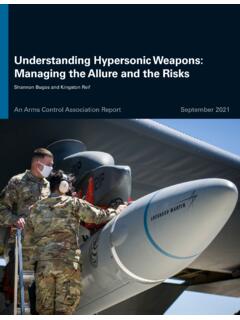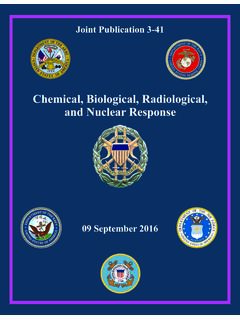Transcription of Nuclear Waste Storage Sites in the United States
1 Updated April 13, 2020 Nuclear Waste Storage Sites in the United StatesCongressional interest in Nuclear Waste is generally focused on managing commercial spent Nuclear fuel (SNF), the Waste produced from commercial Nuclear power plants, and other high-level Nuclear wastes (HLW), largely from Cold War era Nuclear weapons materials production. No country, including the United States , has a permanent geologic repository for disposal of commercial SNF and other HLW. Currently, commercial Nuclear power plants generally store SNF on site, awaiting disposal in a permanent repository.
2 The Nuclear Waste Policy Act of 1982 (NWPA; 97-425) authorized the Department of Energy (DOE) to site a geologic repository for the permanent disposal of high-level radioactive Waste . Congress amended the NWPA in 1987 to designate Yucca Mountain, NV, as the only location to be considered by DOE to construct a national high-level Nuclear Waste repository. Political and legal opposition to the project has delayed the licensing, construction, and operation of the proposed Yucca Mountain repository. NWPA authorized DOE to enter into agreements with Nuclear utilities and other reactor owners to collect fees to pay for DOE s disposal of the SNF.
3 However, due to the delay in operation of a permanent repository, the federal government has paid roughly $ billion from the Judgment Fund to Nuclear utilities and other reactor owners pursuant to court settlements and final judgments through FY2018. Figure 1 shows the locations of 80 Sites in the United States where Nuclear Waste is currently stored. At 57 of these Sites , 96 operating Nuclear reactors generate approximately 20% of the total annual electricity production for the United States . A site in Figure 1 is a geographically distinct location.
4 In some instances, multiple Nuclear reactors may be co-located (operating or not) at a single site. Generation of Spent Nuclear Fuel and Other High-Level Nuclear Waste Commercial civilian Nuclear reactors use low-enriched uranium oxide to generate Nuclear power through fission reactions. The heat from fission in the reactor drives a steam turbine and a generator. Over time, the reactor fuel becomes incapable of economically producing power ( , spent ) and must be replaced. Fuel assemblies removed from the reactor following power production are called spent Nuclear fuel.
5 SNF is stored in one of two ways: in wet Storage pools and in dry casks. Immediately following power production, SNF is discharged from the reactors and stored in wet Storage pools on site, as it remains intensely radioactive and thermally hot. Wet pools provide regulated conditions allowing the SNF to cool while water is circulated and maintained to keep it from boiling off and uncovering the SNF. Some Sites store SNF using a combination of wet Storage and dry casks. Following the initial cool-down period, most facilities transfer SNF to dry casks and store it on site.
6 Dry cask Storage of SNF does not require active cooling dependent upon pumps. Plant operators place dry casks within a security perimeter outside of the reactor building, either vertically on a concrete pad or within an engineered concrete bunker. HLW stored at DOE Sites is characteristically different from SNF produced at commercial Nuclear reactors. The historical production of Nuclear warheads by DOE and its predecessor agencies generated most HLW, which consists of radioactive liquids from reprocessing SNF and extracting special Nuclear materials.
7 DOE manages most HLW as liquids in underground tanks. DOE has converted some HLW to a powder form and some has been solidified in glass for future disposal. Nuclear Waste Storage In the absence of a permanent geologic repository for high-level Nuclear Waste , commercial Nuclear power plants have been storing SNF on site using wet pool and dry cask Storage methods pursuant to regulations promulgated by the Nuclear Regulatory Commission under the Atomic Energy Act, as amended ( 83-703). The Nuclear Waste Technical Review Board estimates the quantity of SNF stored as of 2012 at commercial Nuclear power plants will approximately double by 2048.
8 Stranded Sites At 23 Nuclear Waste Storage Sites (29% of the total Sites ), there are no ongoing reactor operations. These stranded Sites are facilities that store Nuclear Waste but lack an operating reactor generating power and revenue. Stranded does not imply that the Waste has been abandoned or lacks regulatory oversight. Sites where operating and shutdown reactors are co-located are not considered stranded Sites regardless of the presence of stored SNF from a co-located closed reactor. Issues for Congress Among other proposals, the House- and Senate-introduced versions of the Nuclear Waste Policy Amendments Act of 2019 ( 2699 and S.)
9 2917) in the 116th Congress would authorize DOE to initiate a program for developing consolidated interim Nuclear Waste Storage Sites during the ongoing development and construction of a permanent repository. Other bills introduced in the 116th Congress included S. 1234, which would establish the Nuclear Waste Administration to manage Nuclear Waste and ensure funding for managing Nuclear Waste , among other purposes. Senators and Representatives from Nevada the state where the proposed Yucca Mountain repository is located introduced legislation in the 116th Congress ( 1544 and S.
10 649) to require DOE to obtain the consent of Nuclear Waste Storage Sites in the United States local and state governments prior to expenditures from the Nuclear Waste Fund for the repository. Figure 1. Nuclear Waste Storage Sites in the United States Sources: Compiled by CRS using various Nuclear Regulatory Commission and Nuclear Energy Institute sources, including Evaluation of Options for Permanent Geologic Disposal of Spent Nuclear Fuel and High-Level Radioactive Waste in Support of a Comprehensive National Nuclear Fuel Cycle Strategy, FCRD-UFD-2013-000371, Revision 1; SAND2014-0187P (vol.













